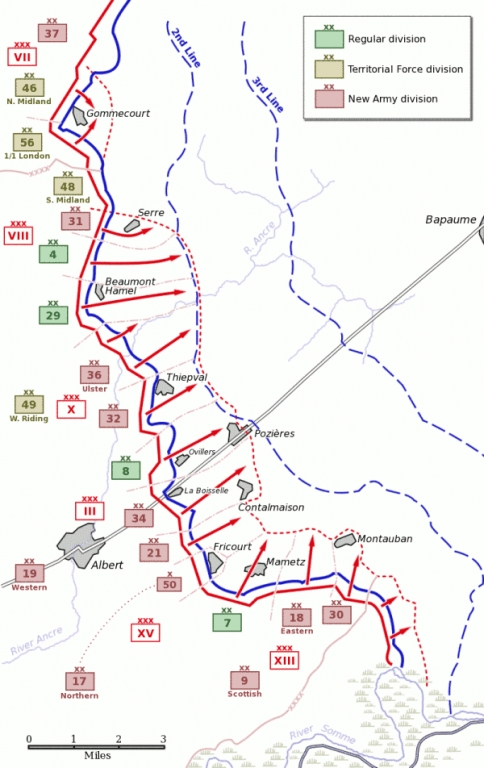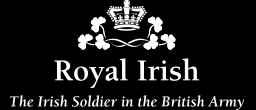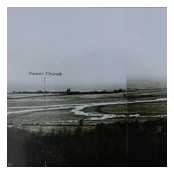The 36th (Ulster) Division on 1 July 1916

|
The Battle Honour ALBERT 1916 is emblazoned on the King’s Colour of The Royal Irish Regiment.
————————————————-
In December 1915, the Allies had agreed to launch a general offensive against the Central Powers in 1916. The plan included a decisive combined British and French offensive against Germany on the Somme. However, that plan had to be modified when the Germans began to 'bleed France white' during the Battle of Verdun. The 36th (Ulster) Division had been in the trenches of the Somme sector, north of the River Ancre, since February 1916. As spring arrived, the waterlogged trenches dried and the battle-scarred landscape was hidden under grass and summer flowers. Training intensified and the soldiers of the 36th (Ulster) Division knew that they were preparing for a great offensive.
 The British Fourth Army's main line of assault would run for 25,000 yards, nearly 14 miles, from Serre in the north to Montauban to the south (map,left). The sector had long been quiet and the Germans had used this time to construct formidable defences of three consecutive lines, complete with railway tracks to carry supplies to the front. Each wood and village concealed a strongpoint with deep dugouts, many of which went down 40 feet and could hold a company of 200 men. These underground galleries were supplied with electricity and running water, had communications and first aid facilities, and could withstand the heaviest bombardment.
The British Fourth Army's main line of assault would run for 25,000 yards, nearly 14 miles, from Serre in the north to Montauban to the south (map,left). The sector had long been quiet and the Germans had used this time to construct formidable defences of three consecutive lines, complete with railway tracks to carry supplies to the front. Each wood and village concealed a strongpoint with deep dugouts, many of which went down 40 feet and could hold a company of 200 men. These underground galleries were supplied with electricity and running water, had communications and first aid facilities, and could withstand the heaviest bombardment.
The Allies had counted on annihilating the German first line defenders with a week-long artillery bombardment the like of which had never been seen before; 1,732,873 shells were fired from 24 June - 1 July but too many rounds fell short, were premature bursts or failed to explode. From 24 June, the soldiers had listened to the cacophony and imagined themselves going over the top to find no Germans alive.

(Right, the artillery bombardment of the 109 Brigade objective - the Schwaben Redoubt, 1 July 1916; © IWM (Q 11))
The 36th (Ulster) Division was the left division of X Corps and had been assigned the Thiepval/Ancre Heights sector, considered the key to the whole enemy line and the toughest area to attack (click on map, top-right). Major General O S W Nugent, commanding the 36th (Ulster) Division, fully realized that stopping the heavy preparatory bombardment ten minutes before the 0730 Zero Hour would give the Germans ten long minutes to come up out of their trenches and into position to meet the anticipated attack. Thus, he ordered that his Division would leave their assembly trenches prior to Zero Hour (0730 hours) and move forward to start lines. He calculated that although he might suffer losses from his own bombardment, the advantage of getting on top of the German 'Line A' under artillery cover far outweighed the risk.
The Ulster Division was to capture the German front line between the River Ancre on the left and Thiepval on the right. The 29th Division, the right division of VIII Corps, was to the left (north), the 32nd Division to the right (south) and the 49th Division to the rear. General Nugent divided his front into four sections. The left section, on the right (north) bank of the Ancre, was allocated to 108 Brigade. The left centre section, bounded by a line drawn from the north corner of Thiepval Wood just north of B 19, C 11, and D 11, and the Ancre, had its approaches through the Ancre marshy area and was not to be attacked directly. The right-centre section was allocated to 108 Brigade and the right section to 109 Brigade. The Divisional Reserve was to be 107 Brigade. The Division would therefore attack with 108 Brigade on the left astride the river Ancre, the objective being Beaucourt railway station over one mile away beyond the German third line, and 109 Brigade on the right with its objective as the formidable Schwaben Redoubt. The Divisional Reserve, 107 Brigade was to advance behind 109 Brigade and then pass through the Schwaben Redoubt and capture the German D line beyond.
 By 2200 hours on 1 July, after a day of slaughter and sacrifice, the remnant of the 36th (Ulster) Division was forced back to the extent that it had no troops in any of the German lines except the dead, wounded and captured. When it was relieved by the 49th Division the following day the 36th (Ulster) Division had over 5,000 casualties. The dead numbered 2,069. All three regiments were awarded the Battle Honour ALBERT 1916, for the opening phase of the Somme Offensive, oficially designated the Battle of Albert, for the fighting from 1-13 July 1916.
By 2200 hours on 1 July, after a day of slaughter and sacrifice, the remnant of the 36th (Ulster) Division was forced back to the extent that it had no troops in any of the German lines except the dead, wounded and captured. When it was relieved by the 49th Division the following day the 36th (Ulster) Division had over 5,000 casualties. The dead numbered 2,069. All three regiments were awarded the Battle Honour ALBERT 1916, for the opening phase of the Somme Offensive, oficially designated the Battle of Albert, for the fighting from 1-13 July 1916.
What happened to 107 Brigade?
What happened to 108 Brigade?
What happened to 109 Brigade?











